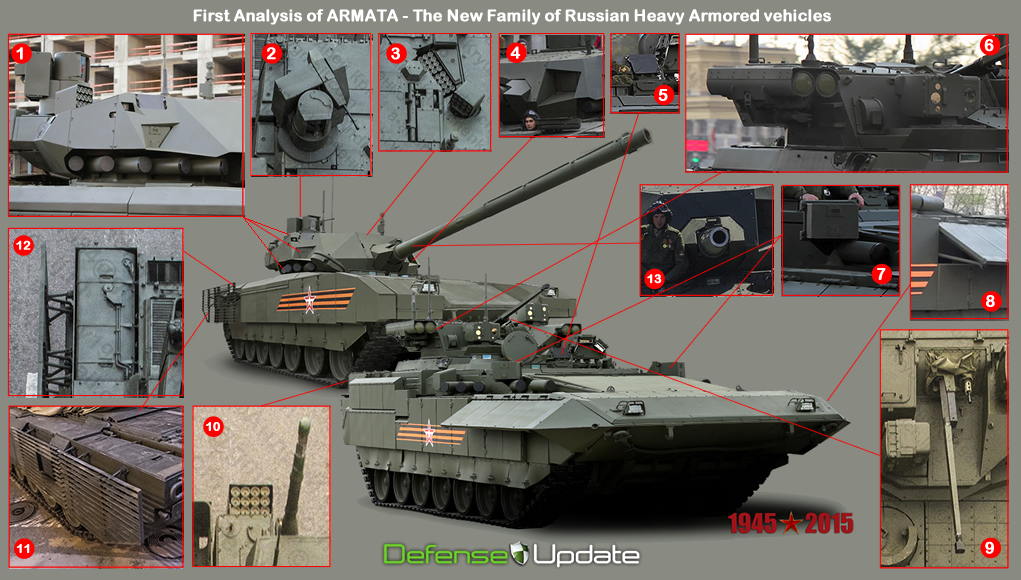
The Russian Ministry of Defense today publicly presented the first members of the Armata family of heavy armored vehicles – the T-14 main battle tank and T-15 armored infantry fighting vehicle. The two vehicles are designated to become the spearhead of the armored formations of the Russian Army – replacing the T-72, BMP-2 and MT-LB-based platforms. In Armata-centered formations, these two combat vehicles will be augmented by additional variants that have not yet been unveiled, which could include a combat engineer and counter-mine vehicle (BREM), support platforms mounting automatic cannons, missiles (Terminator) and thermobaric rockets (TOS), self-propelled guns (Coalitzia), bridge layers (MTU), and armored recovery vehicles (ARV).
The 24 Armata platforms shown on the May 9th parade in Moscow are likely to be part of the early production series, some were especially prepared for the parade, according to aRussian MOD tender published in November 2014. Nevertheless, these models represent an innovative ‘clean sheet’ design of an armored vehicle. Although the two vehicles presented have different configurations they also have much in common, as their designers have used common subsystems to simplify training, improve field support and reduce life-cycle cost. These common elements include the suspension system, tracks, drivetrain, and some of the armor and active protection systems. Both vehicles use seven torsion bars with shock absorbers for the rubber-protected road wheels.
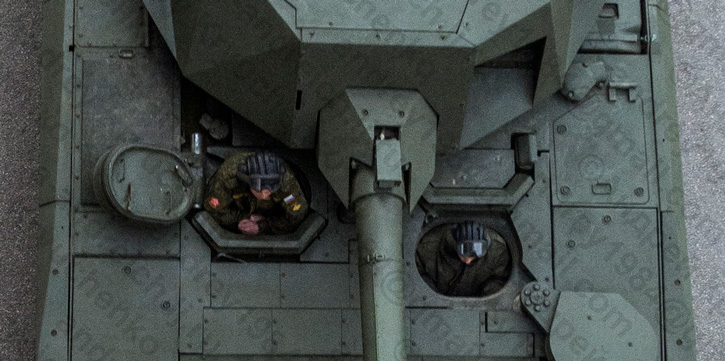

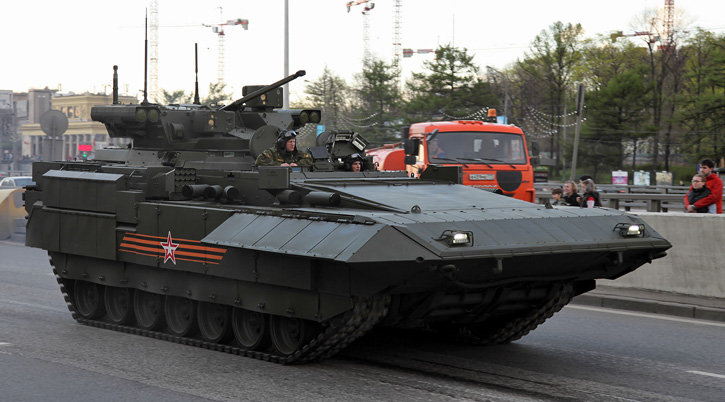


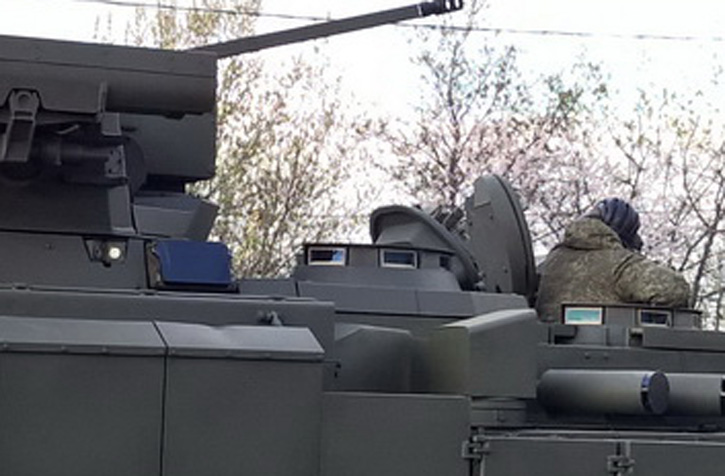

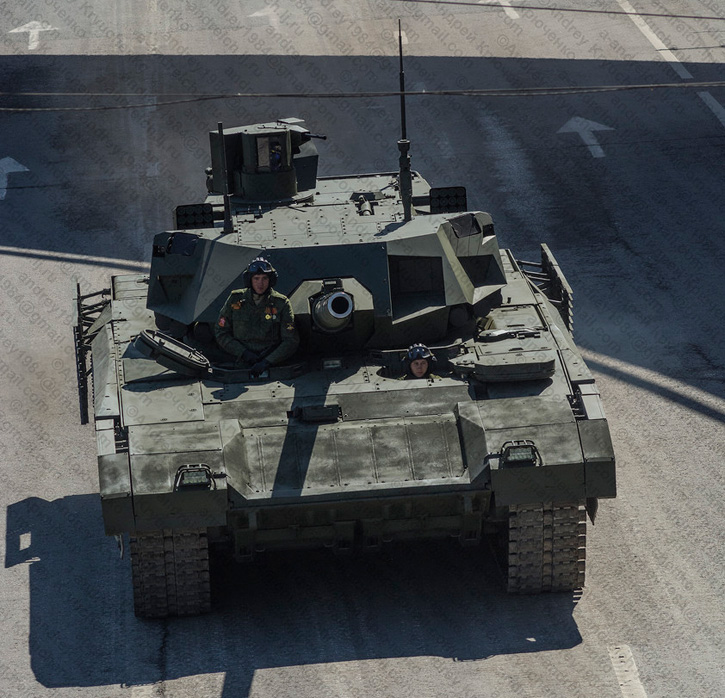

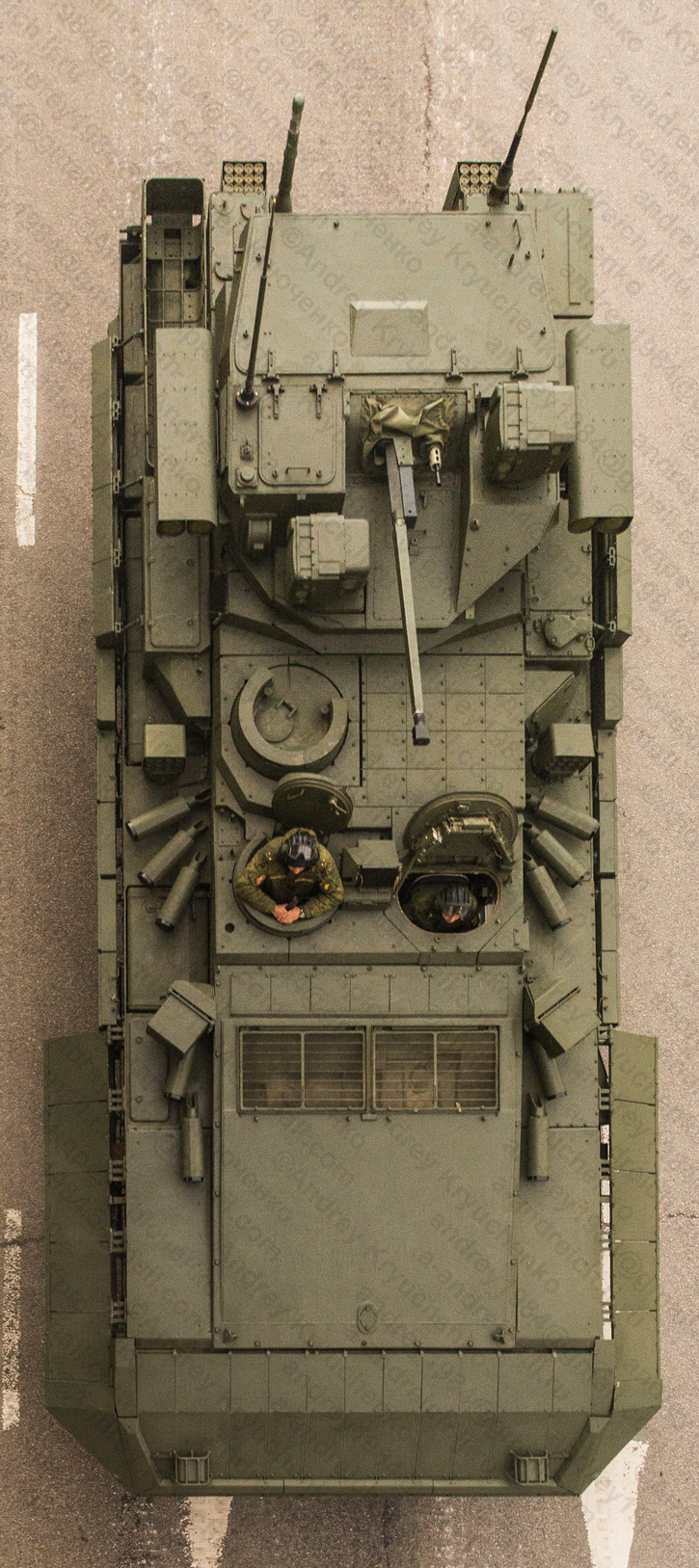
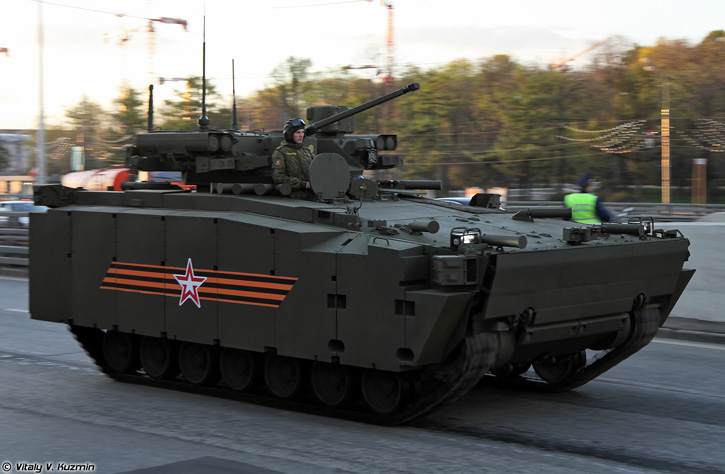

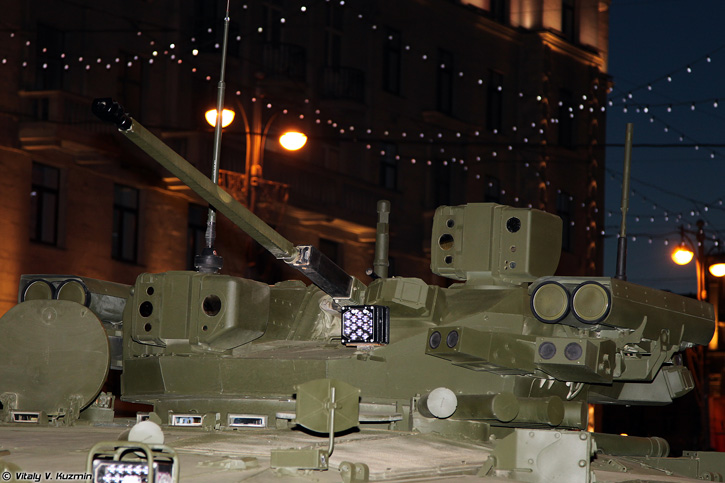
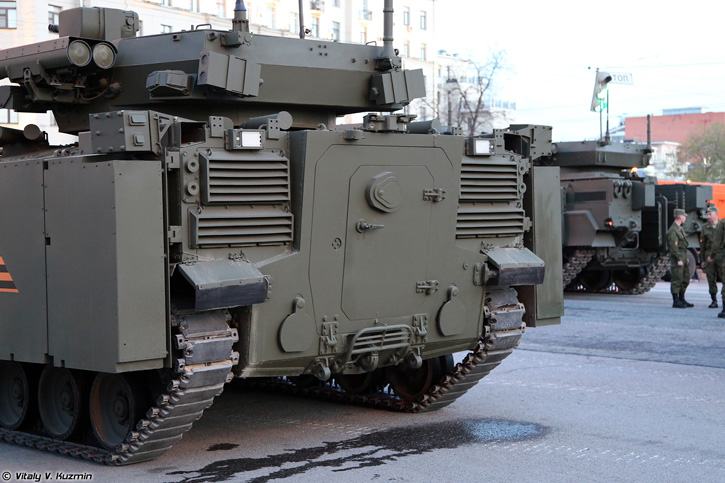
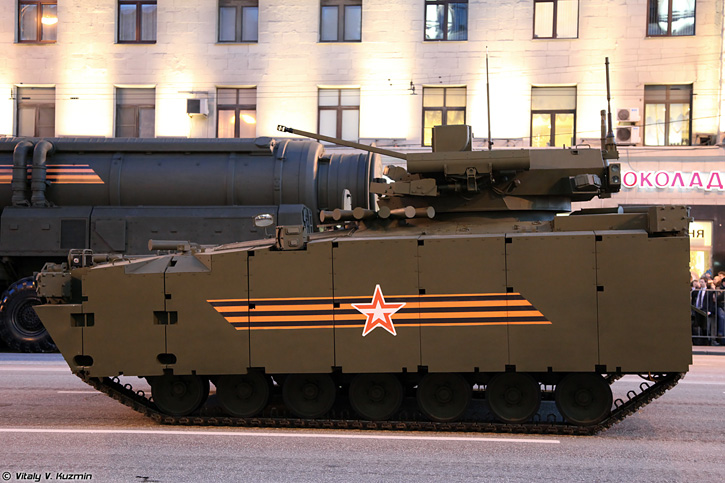
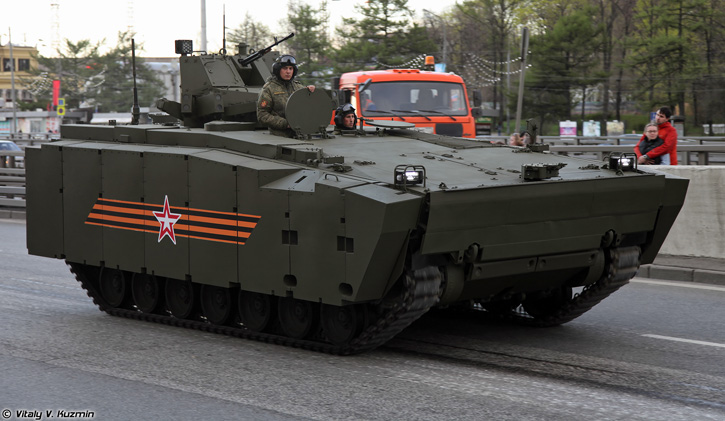
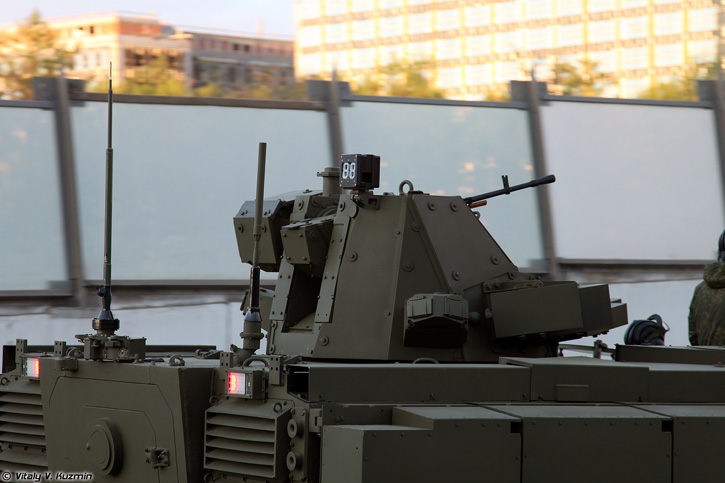
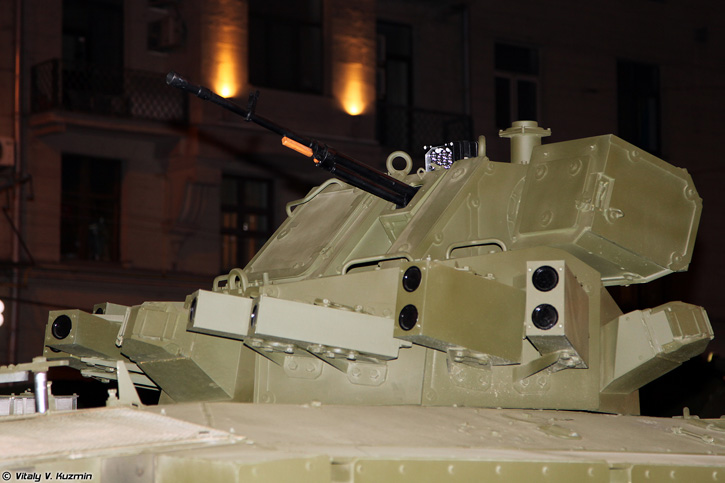

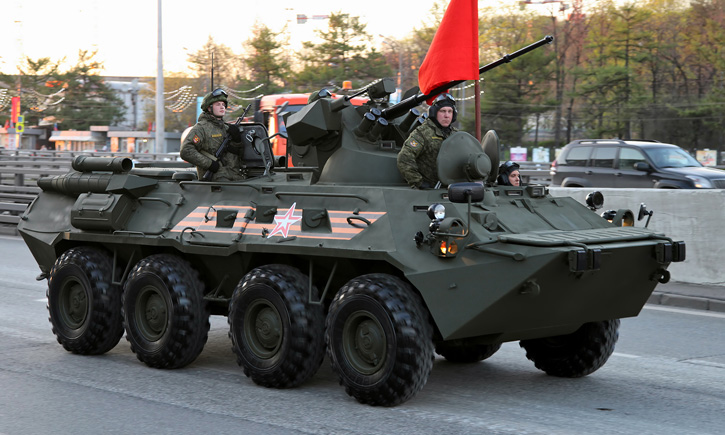
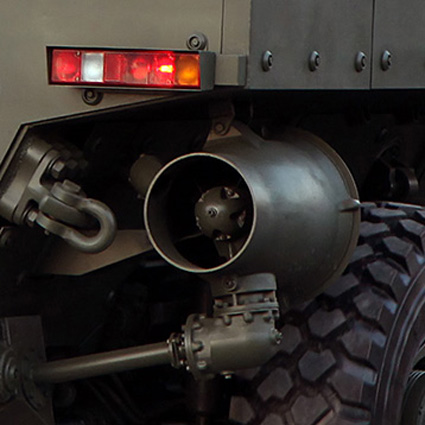
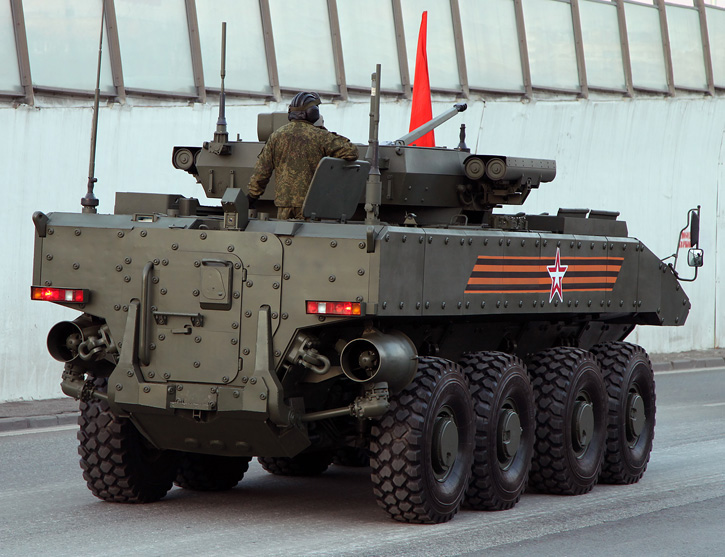
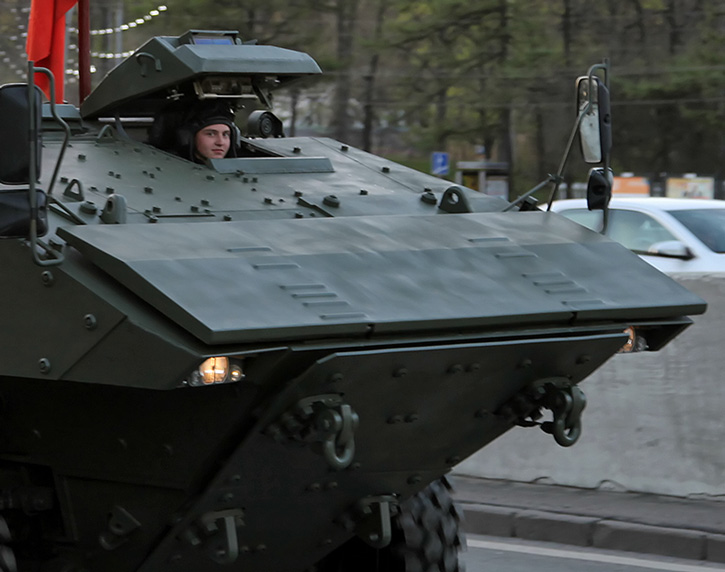
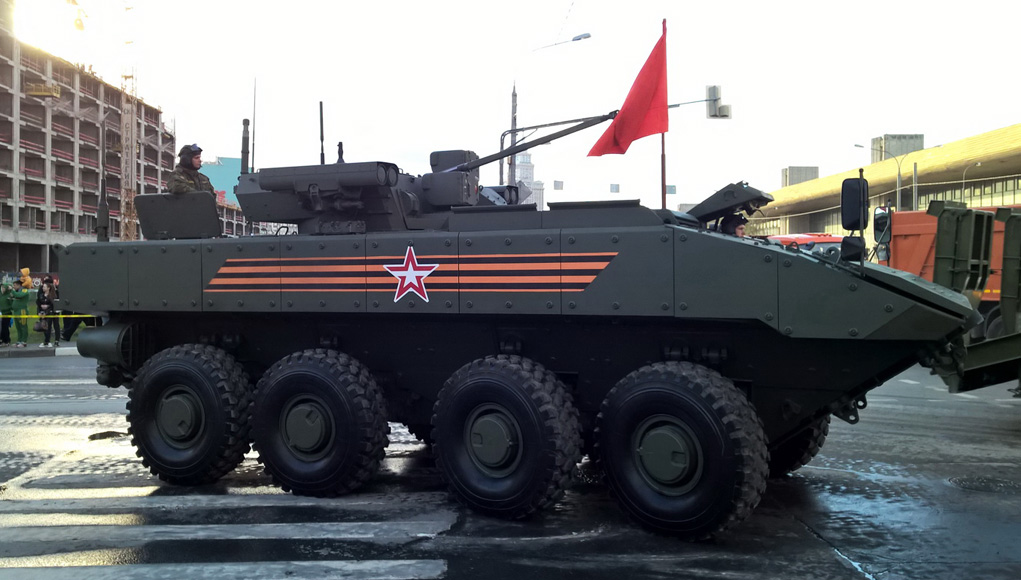
The optronics, however, are tailored specifically for each weapon system, and therefore differ considerably in each application. Seating arrangements are also similar, with two crew members seated side-by-side and a third in tandem with the driver in the T-14, and with the commander, in the T-15. According to some sources there are ‘dozens of cameras’ on the tank, providing full situational awareness around the tank and beyond, in day, night and under adverse weather conditions.
The armor suite used on the T-14 also seems to share some common elements with the T-15. Many of the passive armor modules are similar, if not identical, in some locations. Same concepts are also employed – steel, hybrid and reactive armor, mine countermeasures in front, bar armor protecting the engine compartment and dual active protection system. Both vehicles employ remotely-operated weapon turrets, separating the crew from the armament and ammunition. Both vehicles are operated by a crew of three. The T-15 can also accommodate an infantry squad in the passenger compartment. However, unlike the BMP-2, these soldiers do not have periscopes, firing ports or individual access hatches. Therefore, the infantry squad would come into effect only after dismounting.
The current turret mounts a 125mm smooth bore cannon, without a coaxial weapon (previous reports indicated it had a 30mm coaxial gun and 7.62mm machine gun). While the turret has a distinctive shape dictated by the panels covering its various systems, its basic structure is likely to be thinner, providing a framework for a modular weapon system that could also support cannons of various calibers, automatic mortars or other support weapons.
The shrouded 125mm 2A82-1M cannon is different from previous models used on the T-90 and T-72. The main difference is the absence of a bore evacuator (since the gun compartment is separate from the crew compartment, extracting the combustion gasses from the gun is not necessary for crew safety.) A small box likely to be a gun reference system is located above the gun, providing exact measurement of barrel deformations for ballistic calculation (13). A meteorological mast is also located on the turret of the T-14, or the rear section on T-15 (10), feeding data to the ballistic computer. The cannon fires standard ammunition as well as gun-launched missiles, with a range of eight kilometers.
The T-15 uses an ‘off the shelf’ KBP EPOCH turret, also used on the Kurganets-25 BMP. This turret integrates a single 30mm cannon with 500 rounds (AP/HE), a 7.62mm coaxial machine gun, four Kornet-EM missiles (two on each side), and two fire control systems, integrating electro-optical sights, a laser rangefinder and laser guidance system (for the Kornets). The two systems are contained in ballistic protected modules, adding resilience to this combat vehicle. (6, 9)
A 7.62mm machine gun is mounted on the remotely-operated weapon station, integrated with what seems to be the independent, panoramic sight of the commander. (2) The gunner’s main sight (4) is located in a protected cell to the right of the main gun, enabling the gunner and commander to engage different targets.
Additional weapons could be introduced in an alternative turret design; the current one lacks the installation for such weapons. A compartment located above the gun could provide space for an additional weapon assembly mounted above the gun.
(1, 7) The T-14 turret also houses two active protection systems, comprising the Afghanit hard-kill APS (five launch tubes recessed at the turret base), and four soft-kill countermeasure launchers – two are positioned on rotating pedestals and two are pointing upwards (3, 10). These are likely to launch salvos of projectiles instantly creating a thick, multi-spectral smoke screens designed to defeat guided missiles, laser and targeting systems by blocking infrared, visible light and millimeter-wave radar radiation. These soft-kill countermeasures are designed to protect the vehicle from 3rd and 4th generation missiles such as direct attack Hellfire, TOW and BILL, or Brimstone, JAGM, Javelin or Spike missiles, approaching at high trajectory, as well as from nearly vertical top-attack by sensor-fused weapons (SFW).
A total of 10 Afghanit canisters are used, five on each side of the turret. When the turret points forward, they protect the forward arc (about 60 degrees on each side). When a threat coming from the sides or rear is detected, the turret will automatically slew toward the threat, enabling the APS to launch. Lacking this turntable function, T-15 uses the same five tubes in fixed positions, on both sides of the vehicle, covering only the forward arc. The tube objects are seemingly a smaller, more efficient evolution of the Drozd ‘explosive screen’. Afghanit is likely employing these countermeasures at close range, neutralizing incoming threats before they hit the tank armor. A previous version of APS from Russia, the Arena, employed an explosive ‘cassette’ launched above the incoming threat, firing a screen of blast and fragments downward.
Each of the APSs has its own sensors as well, mounted on each side of the turret, covering the rear and front quadrants left and right. The sensor (5) coupled with the pedestalled and upward pointing fixed countermeasures seems to be covered by a flat panel. Several sources indicated the Armata (T14 and T15) have the capability to detect, and simultaneously track and locate 40 land targets and 25 air targets. If this is indeed that sensor, it is likely to be AESA radar panels. There is no indication of such radar on the vehicle except those flat objects mounted on both sides of the turret. There are four such sensors on each vehicle (T-14, T-15), providing hemispheric coverage, thus detecting potential top attack threats before they enter a lethal zone (SFW).
Although the two designs share the same suspension and drive train, the layout of those systems is different. Both have seven road wheels, four suspension idlers and steel tracks. The T-14 has the turbo-charged diesel engine is mounted in the rear section, with a rear sprocket and front tension wheel. This design places the main weapon system in the center and the crew in the front for best visibility. The T-15 has its engine in the front, with the sprocket pulling its tracks also placed in the front and a tension wheel at the rear. This design clears space for the infantry squad at the rear and also adds some protection up front.
The engine develops 1,500 hp (moderated to 1,200 hp for optimal range). Serving the engine air intakes, cooling and exhaust require special armor adaptations. The T-14 uses a slat armor (11) to protect these elements and the engine compartment from RPGs, leaving the necessary space for air intake and exhaust. The T-15 uses a skirt (8) of oblique armor panels covering the exhaust from above, but these leave enough space to direct the exhaust gases away from the vehicle. The external fuel tanks (12) positioned on the engine’s sides also add protection. Unlike the jettisonable barrels used on the previous Russian tanks, these external tanks are fixed, and, therefore, are likely to be consumed first to reduce vulnerability in combat.
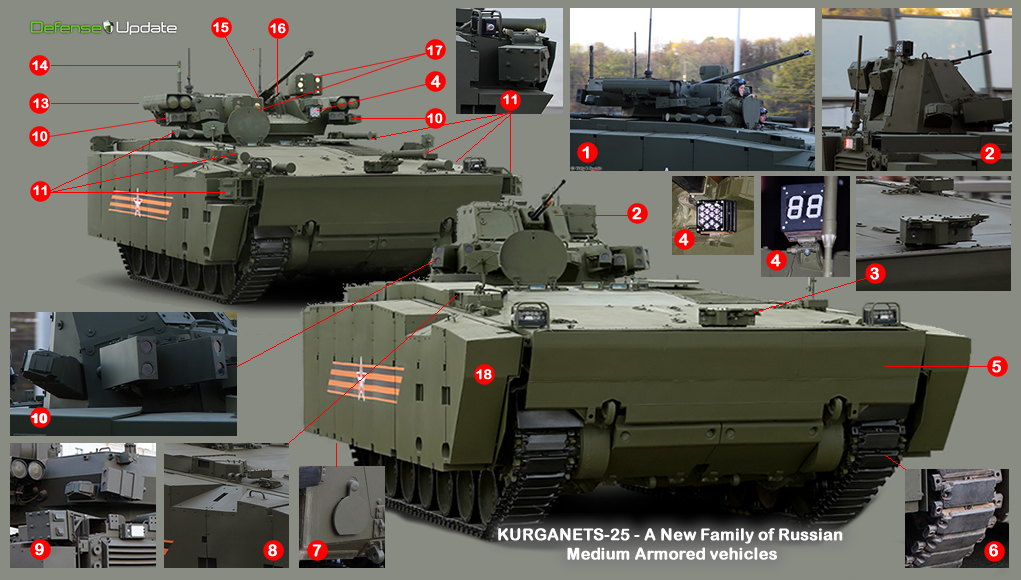
Kurganets-25 family of armored combat vehicles includes two members of a new family of medium- armored vehicles designed to replace the BMP-2 and MT-LB platforms in mechanized formations of the Russian army. Like their predecessors, the new vehicles have amphibious capability, enabling uninterrupted mobility across rivers. The Kurganets is manufactured by Kurganmashzavod, the plant that produced the previous generations of BMP-1, BMP-2 and BMP-3 vehicles.
The new platform is significantly heavier and larger than its predecessors, primarily due to the increased level of protection it offers. The Russians have displayed two variants of the Kurganets – the armored infantry fighting vehicle (Object 695) and the armored personnel carrier (Object 693). The Kurganets-25 infantry fighting vehicle is currently undergoing trials in the Russian army, and mass production is expected to start in 2016. Following is an overview of the different elements visible on the vehicles shown in the May 9th parade in Moscow.
Both vehicles share the same hull, suspension and drive train powered by a 800 hp diesel engine, enabling mobility, as stated, both on land and in water. Their steel tracks are fitted with rubber pads (6), designed to reduce ground pressure and damage to roads, while retaining the capability of travelling at high speeds. Both can reach speeds of up to 80 km/h on land, and 10 km/h in water. When travelling in water the vehicle deploys its wave breaker (5) and water jets (7) for forward movement and steering.
The main difference between the two variants is the turret and active protection systems used. The thick armor covering (18) seen on both sides of the vehicle is designed to provide armor protection while retaining the floating capability necessary to enable the amphibious operation.
The Kurganets-25 infantry fighting vehicle is equipped with the KBP EPOCH turret (1), introduced as standard in all recent AFVs, such as the Armata T-15, Boomerang and Kurganets-25. This unmanned turret carries the 2A42 30mm cannon (15) with 500 rounds, a PKT 7.62 mm coaxial machine gun (16), four Kornet-EM guided missiles (two on each side – 13), two electro-optical target acquisition and missile guidance systems (17), and a meteorological mast (14). Also an array of sensors (9) and counter-measures, part of the vehicle’s active protection system ‘soft kill’ elements (10).
The hull also mounts 16 large tubes and four sensors (11) associated with the Afghanit ‘hard kill’ active protection system. A LED spotlight (4) located at the turret’s front end could also be part of the APS, acting as a decoy against 2nd-generation anti-tank guided missiles (ATGM).
The Kurganets-25 is equipped with several cameras, covering a full 360 degrees (3). Some of these cameras are stacked to cover wide fields of view. Others are tucked into the armor. For example, the side-looking cameras required special adaptation of the armor to clear their fields of view (8).
Unlike Russia’s previous armored personnel carriers, the Kurganets-25 lacks firing ports or personal hatches which would enable the infantry team to fight from within the vehicle. Part of the reasons for that could be the APS that fires automatically against incoming threats, creating flash and blast that could incapacitate exposed personnel nearby. Similar installations used on Israeli Merkava Mk4 tanks were equipped with blast deflectors, protecting the tank commander that could be exposed in his cupola.
Both variants are operated by crews of three. The infantry fighting vehicle is designed to carry six infantrymen. The armored personnel carrier (APC) variant can carry eight.
The APC carries a smaller remotely-operated turret (2), mounting a single 12.7 mm heavy machine gun. The vehicle retains the same active protection system ‘ring’ used on the BMP, but does not include the heavier Afghanit the BMP uses. Instead, it’s infra-red spotlight (4) is mounted at a higher level, and can serve both as a forward looking counter-measure and a signalling element, displaying numerical symbols backward, thus enabling communications with the infantry squad or other vehicles without relying on radio communications (similar to using flags). If coupled to the laser warning system on the vehicle, such a device could act as an unaided ‘blue force identification’ mechanism, responding to laser signals with a coded message. It would probably operate in visible and thermal bands, enabling both day and night operation.
The Boomerang is operated by a crew of three, and has a carrying capacity of 9 troops. In line with other modern 8×8 APCs, its fighting compartment is more spacious than previous BTRs. Its engine, which is located on the right side and its turret, mounted on the deck, not penetrating the armor, do not obstruct its internal space. This layout enables the troops to exit from the rear ramp, similar to the tracked BMPs. Although common with western 8×8 APCs, it did not exist in earlier Russian 8×8 vehicles.
Their previous models – BTR-82, followed the same design introduced with the BTR-60, which used side doors for troop access, since the engines prevented access to the protected capsule from the rear, while the manned 14.5 mm gun turret blocked it in the front. The only way out was through a clamshell access door on the side, or personnel hatches on the top and side. This proved to be a major drawback in combat, as the troops had to dismount the vehicle exposed to enemy fire from the front and side. It also limited communications between the crew and squad during dismounted operation.
Also gone are the personal periscopes and firing ports which enabled mounted fighting for the troops. Instead, the Boomerang provides a panoramic view generated by video cameras covering the vehicles to a full 360 degrees (3).
Two hatches are mounted on top (7), retaining some functions for the troops. These hatches are likely blocked in models provided with active protection systems.
The Boomerang is built with a different approach – enabling protected mobility for an infantry squad, while providing fire support for them, both on the move and in stationary positions. It is a bigger platform than that of its predecessor, also heavier and more powerful. As opposed to its predecessor’s simple steel armor, the Boomerang has compound, modular armor, combining different materials and an optional (6) active protection system. (Such a system was not visible in the photos we have obtained thus far, but is shown one appears on the model released by the Russian Ministry of Defense).
The vehicle is protected with additional, modular armor at the front, which could also be part of a belly protection plate (8). The V shaped hull is designed to deflect blast away from the floor, in case of a mine or IED explosion underneath the vehicle or under a wheel. Boomerang can be fitted with heavier armor, but such configuration is likely damage its floating ability.
Like the tracked Kurganets-25, the Boomerang comes in two basic models, differing from each other by the type of armament with which they are equipped – an armored infantry fighting vehicle (1) mounting the EPOCH (2) remotely-controlled weapon system (RWS) fitted with a single 2A42 30 mm cannon, 7.62 mm coaxial machine gun and four Kornet-EM guided missiles. These are significant improvement over the previous 14.5 mm heavy machine gun turret used on the BTR-82. The armored personnel carrier is armed with a smaller RWS, mounting a 12.7 mm heavy machine gun (5).
The Boomerang is powered by a single turbo-charged diesel engine, the same type that powers the Kurganets-25 platform. It is an 8×8 vehicle, with steering on the two front axles. All wheels use MacPherson-type suspension (4), with both front and rear wheels fitted with double shock absorbers. The drive train also has two extensions powering the water jets for amphibious operation (10). A folding wave breaker (9) mounted above the front hull, extracted to is released to clear the deck while operating in water.
Other variants expected to follow include a self-propelled gun, a mortar carrier, a command vehicle and other combat support variants. An 8×8 vehicle called ‘ATOM’ was displayed at the ARMS 2013 expo in Nizhny Tagil, fitted with a 57mm cannon. At the time ATOMwas presented as a collaborative effort between UralVagonZavod (UVZ) and Renault Defense Trucks of France, though to be a competing track to the Boomerang.
No comments:
Post a Comment